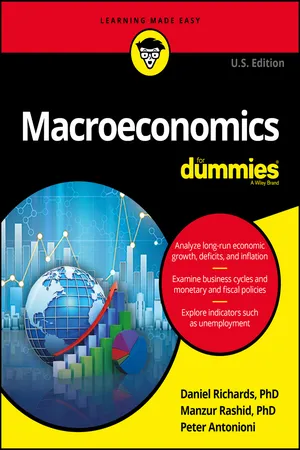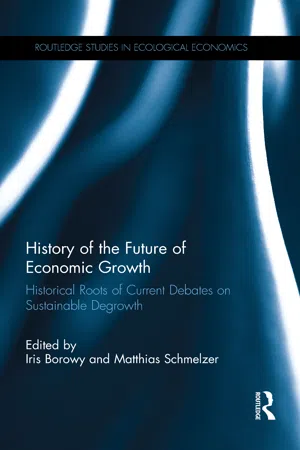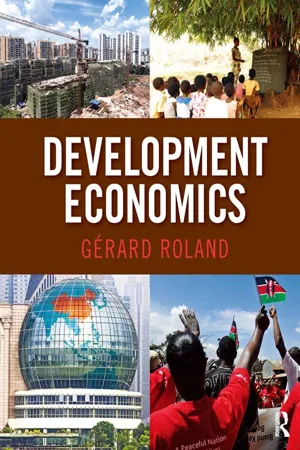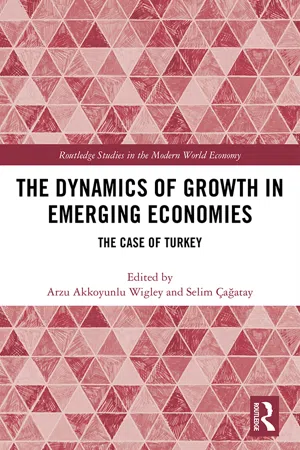Economics
Long-Run Economic Growth
Long-run economic growth refers to the sustained increase in an economy's production of goods and services over time. It is typically measured by the growth in a country's real GDP. Factors such as technological progress, investment in physical and human capital, and institutional improvements contribute to long-run economic growth.
Written by Perlego with AI-assistance
Related key terms
Related key terms
1 of 4
Related key terms
1 of 3
9 Key excerpts on "Long-Run Economic Growth"
- eBook - ePub
Education Economics
Empowering Minds, Fueling Economies, a Journey Into Education Economics
- Fouad Sabry(Author)
- 2023(Publication Date)
- One Billion Knowledgeable(Publisher)
Chapter 4: Economic growth
Economic growth is the increase or improvement in the inflation-adjusted market value of the goods and services produced by an economy during a given fiscal year. Conventionally, statisticians calculate this growth as the percentage rate of increase in real and nominal gross domestic product (GDP).Typically, growth is measured in real terms – i.e., terms adjusted for inflation – to eliminate the distorting effect of inflation on the prices of produced goods. National income accounting is employed to measure economic growth.The "rate of economic growth" refers to the geometric annual growth rate in GDP between the first and last year over a given time period. This growth rate represents the trend in the average level of GDP over the period and excludes fluctuations around this trend.Economists refer to economic growth resulting from a more efficient use of inputs (increased labor productivity, physical capital productivity, energy or material productivity) as intensive growth. In contrast, GDP growth caused solely by increases in the quantity of inputs available for use (such as increased population or new territory) is considered extensive growth.The economic growth rate is computed using GDP data estimated by statistical agencies. The analyst calculates the rate of growth of GDP per capita using data on GDP and population for the initial and final periods included in the analysis.Furthermore, the change in living standards over time varies greatly from nation to nation. Below is a table detailing the per capita gross domestic product (GDP) and annualized per capita GDP growth for a number of nations over the past century. The GDP per person figures are inflation-adjusted, so they are "real." GDP per person (more commonly referred to as "per capita" GDP) is the country's total GDP divided by its population; it is conceptually equivalent to "average income.". - eBook - ePub
Economic Development
Empowering Prosperity, a Comprehensive Guide to Economic Development
- Fouad Sabry(Author)
- 2023(Publication Date)
- One Billion Knowledgeable(Publisher)
Chapter 3: Economic growth
Economic growth is the increase or improvement in the inflation-adjusted market value of the goods and services produced by an economy during a given fiscal year. Conventionally, statisticians calculate this growth as the percentage rate of increase in real and nominal gross domestic product (GDP).Typically, growth is measured in real terms – i.e., terms adjusted for inflation – to eliminate the distorting effect of inflation on the prices of produced goods. National income accounting is employed to measure economic growth.The "rate of economic growth" refers to the geometric annual growth rate in GDP between the first and last year over a given time period. This growth rate represents the trend in the average level of GDP over the period and excludes fluctuations around this trend.Economists refer to economic growth resulting from a more efficient use of inputs (increased labor productivity, physical capital productivity, energy or material productivity) as intensive growth. In contrast, GDP growth caused solely by increases in the quantity of inputs available for use (such as increased population or new territory) is considered extensive growth.The economic growth rate is computed using GDP data estimated by statistical agencies. The analyst calculates the rate of growth of GDP per capita using data on GDP and population for the initial and final periods included in the analysis.Furthermore, the change in living standards over time varies greatly from nation to nation. Below is a table detailing the per capita gross domestic product (GDP) and annualized per capita GDP growth for a number of nations over the past century. The GDP per person figures are inflation-adjusted, so they are "real." GDP per person (more commonly referred to as "per capita" GDP) is the country's total GDP divided by its population; it is conceptually equivalent to "average income.". - eBook - ePub
- Dan Richards, Manzur Rashid, Peter Antonioni(Authors)
- 2016(Publication Date)
- For Dummies(Publisher)
Part 3The Long-Run Macro Economy
IN THIS PART … Understand the importance of economic growth and the determination of the economy’s long-run growth path. Discover that in the long run, inflation is determined by money growth. Discover that in the long run, real interest rates primarily reflect households’ willingness to save.Passage contains an image Chapter 8
GDP Growth in the Long Run
IN THIS CHAPTER Compounding growth: The rule of 70 Marginalizing firm decisions Growing GDP over time Steadying the stateWe’ve said it before and we’ll say it again: Economists love models. Building an economic model and considering its implications forces you to think hard about which assumptions lead to which results and whether those assumptions make sense. And it’s only after you have a model that you can begin to test it with evidence.Some of the time, or maybe most of the time, economists disagree at one or more of these stages. They argue over assumptions. They argue over the empirical evidence. They argue over arguing. But in macroeconomics, one area where economists don’t argue too much is about the nature of the long run. There is a lot of agreement about the economy’s long-run behavior and which macroeconomic policies will promote a healthy long-run growth path.That long-run path is an anchor — a full equilibrium. It is in fact the potential output described in Chapter 3 , because it reflects full employment of the economy’s capital and labor resources. Whatever happens in the short run, there are forces (sometimes weak but always present) that pull the economy back toward that potential. Put somewhat differently, recessions can cause the economy to drift away from its long-run equilibrium for some time and by a significant amount. But ultimately the economy always returns to that long run, full-employment path.In this chapter, you’ll hear about the long-run growth model that most macroeconomists think works for modern economies like the U.S. You’ll also get an idea of the critical but complicated role that society’s willingness to save plays in that model — and what the long-run equilibrium says about interest rates and the price of credit as well. - eBook - ePub
- Anthony J. Makin(Author)
- 2016(Publication Date)
- Routledge(Publisher)
C H A P T E R 14 Economic growth An economy’s growth rate determines its standard of living on an income per head basis. Around the world, living standards differ markedly. For instance, average household income in many advanced economies is at least ten times higher than in many developing economies. Meanwhile, economies in East Asia, including China, Japan, Singapore and South Korea, have experienced rates of growth unsurpassed in human history that have lifted hundreds of millions of people out of poverty over the past half century. This chapter focuses on the key factors influencing trends in GDP growth, around which an economy’s business cycle fluctuates. At the most fundamental level, well-defined property rights and a well-functioning legal system that foster market exchange are essential for sustained economic growth. Meanwhile, excessive regulation that restricts economic production and exchange stymies economic growth by limiting market exchange. Conventional growth theory explains long-term economic performance with reference to the factor inputs to production – the domestic labour force, the capital stock and technological improvement. Before analysing the relationship between factor inputs and economic growth in depth, let us first consider some historical features of economic growth in advanced economies. Economic growth and living standards The composition of domestic production in advanced economies changed substantially over recent centuries. The relative share of agriculture in GDP shrank dramatically, while manufacturing industry waxed then waned, and services grew to account for well over half of GDP. From the beginning of the previous century, the agricultural sector in Australia, the United States, United Kingdom, Japan and other advanced Eurpoean economies ceased to be a major source of employment - eBook - ePub
History of the Future of Economic Growth
Historical Roots of Current Debates on Sustainable Degrowth
- Iris Borowy, Matthias Schmelzer(Authors)
- 2017(Publication Date)
- Routledge(Publisher)
Introduction The end of economic growth in long-term perspective Iris Borowy and Matthias Schmelzer The future of economic growth is one of the decisive challenges of the twenty-first century. Since approximately 1820, global economic growth has profoundly transformed human life and the planet, and current societies, economies, and cultures are fundamentally built on the expectation of continuing future growth. However, given the exceptional and non-reproducible circumstances, which have given rise to the unprecedented economic expansion of recent history, it seems essentially clear that, irrespective of local or regional developments to the contrary, on a global scale future growth rates will be nowhere near what they have been in the recent past. What is unclear, however, is how societies will react to the end of growth and related crises. What is the significance of economic growth in current societies? How did humanity come to develop this dependence on a growth-centered economy? And what possible alternatives are there and how have they evolved historically? These, among others, are the questions addressed in History of the Future of Economic Growth. Although a highly ambivalent and elusive term, the semantic core of economic growth is statistically fixed. It is generally defined as the annual increase in the Gross National Product (GNP) or Gross Domestic Product (GDP). GNP and GDP measure the monetary value of all the final goods and services produced within a country, including the costs of producing all the services provided by the government. 1 Since production and services are provided and consumed by the inhabitants of a country, GNP/GDP is related to population. Using per capita GNP/GDP allows comparing the economies of countries of different population sizes - eBook - ePub
- (Author)
- 2021(Publication Date)
- Wiley(Publisher)
The labor supply is determined by population growth, the labor force participation rate, and net immigration. The physical capital stock in a country increases with net investment. The correlation between Long-Run Economic Growth and the rate of investment is high.Technological advances are discoveries that make it possible to produce more or higher-quality goods and services with the same resources or inputs. Technology is a major factor determining TFP. TFP is the main factor affecting long-term, sustainable economic growth rates in developed countries and also includes the cumulative effects of scientific advances, applied research and development, improvements in management methods, and ways of organizing production that raise the productive capacity of factories and offices.Total factor productivity, estimated using a growth accounting equation, is the residual component of growth after accounting for the weighted contributions of all explicit factors (e.g., labor and capital).- Labor productivity is defined as output per worker or per hour worked. Growth in labor productivity depends on capital deepening and technological progress.
- The academic growth literature is divided into three theories —the classical view, the neoclassical model, and the new endogenous growth view.
- In the classical model, growth in per capita income is only temporary because an exploding population with limited resources brings per capita income growth to an end.
In the neoclassical model, a sustained increase in investment increases the economy’s growth rate only in the short run. Capital is subject to diminishing marginal returns, so long-run growth depends solely on population growth, progress in TFP, and labor’s share of income. - eBook - ePub
- Gerard Roland(Author)
- 2016(Publication Date)
- Routledge(Publisher)
In the second half of the 18th century, Great Britain industrialized its economy, followed in the 19th century by the United States and Europe. Japan, which had been isolated from the rest of the world for centuries and deeply mired in its feudal traditions, started growing very rapidly at the end of the 19th century. As a result of its economic strength, it was able to create a powerful military that defeated Russia’s tsarist army in 1905 and went on to invade and occupy China and large parts of Asia in the 1930s and 1940s. After Japan’s defeat in World War II, its economy continued to develop very rapidly, with GDP growing at 9% on average between 1950 and 1970. Other Asian countries (Taiwan, South Korea, Hong Kong, and Singapore) experienced rapid growth in the 1960s and 1970s by following the Japanese model of an export-oriented economy. Since the 1980s, China, the most populous country in the world, has had GDP growth of nearly 10% per year. As the Chinese “miracle” has unfolded over the past decades, income per capita has increased by a factor of 10. India has also started to grow vigorously since the end of the 20th century. Underscoring the power of these two emerging economies, India and China together include more than one-third of the world population.It is important to distinguish between economic development and economic growth.Economic developmentrefers to improvements in living standards and in the quality of life, whileeconomic growthmeasures only growth in economic production. Economic growth may not accurately reflect all aspects of economic development because growth often results in negative effects on the quality of life such as pollution and urban congestion. Nevertheless, economic development cannot take place without economic growth. Growth is thus fundamental to development.n this chapter, we introduce some important economic concepts to consider when discussing economic growth. We then review two very important theories of economic growth that explain the capital accumulation process. We will show that these theories, and others, based on capital accumulation explain only a small part of the differences in growth among countries. We then discuss the empirical evidence for the main causes of growth and highlight two important explanations for why some countries are so wealthy and others are so poor: geography and institutions. Currently, economists believe that institutions are central to understanding economic performance and economic growth in developing countries. The impact of institutions on growth will continue to inform our discussion of institutions throughout the remainder of the book.IGrowth and Factors of Production
When we analyze the sources of economic growth, the first thing we must consider is the contribution made by the factors of production.Factors of Production
Consider the output of a firm producing T-shirts. The firm generates output by combining labor and capital (machines, buildings, trucks). Labor and capital are critical factors in the creation of value and in the production of output in an economy. In our example, not a single T-shirt could have left the workshop floor without the combination of labor and capital, which arefactors of production.1 - eBook - ePub
The Dynamics of Growth in Emerging Economies
The Case of Turkey
- Arzu Akkoyunlu Wigley, Selim Ça?atay(Authors)
- 2018(Publication Date)
- Routledge(Publisher)
1 Long-Run Economic Growth in TurkeySources, pitfalls, and prospects
M. Aykut AttarIntroductionLiving standards in Turkey exhibit sustained growth in the long run. The Maddison Project’s data indicate that, from 1870 to 2016, real Gross Domestic Product (GDP) per capita in purchasing power parity corrected terms increased by about 13 times. For the post-1923 republican era, the average annual growth rate of real GDP per capita is roughly equal to 3% (Bolt, Inklaar, de Jong, & van Zanden, 2018).Figure 1.1 pictures the long-run evolution of real GDP per capita in Turkey and some selected economies. The performance with an average growth rate of around 3% is not sufficiently strong for Turkey to converge to frontier countries such as the United Kingdom and the United States. But it is also strong enough to let Turkey maintain the relative level difference with these countries. In short, Turkey’s long-run growth story is neither a miracle nor a disaster.Source: Bolt et al. (2018).Figure 1.1Long-Run Economic Growth in selected economies, 1923–2023.The main objective of this chapter is threefold. It deciphers the sources of intensive economic growth in Turkey from the 1950s to the present. Growth in real GDP per capita originates from productivity growth, human capital accumulation, and fertility decline. The analysis also identifies some pitfalls of the Turkish economy in achieving a long-run growth rate higher than its stable 3% rate. Finally, the analysis focuses on counterfactuals for a quantitative exploration of growth prospects of Turkey for the rest of the 21st century.The chapter develops an overlapping generations general equilibrium (OLG-GE) model with endogenous technological progress, endogenous human capital accumulation, and endogenous fertility choice. The model is eclectic, merging different theoretical mechanisms that explain economic growth within a single framework. It largely builds upon the simple multi-sectoral Schumpeterian model of Aghion and Howitt (2009, Ch. 4 - eBook - ePub
Innovation for Value and Mission
An Introduction to Innovation Management and Policy
- Peet van Biljon(Author)
- 2022(Publication Date)
- De Gruyter(Publisher)
Chapter 3 Economic Growth and InnovationIt is important for anyone interested in innovation policy to have had at least an introduction to the key economic ideas and differing schools of economic thought that link growth to innovation and technological advancement. This is a very large area of study, and economists have written entire textbooks and countless papers just on the topic of growth. It is not the intent of this chapter – nor is it realistic given the space available – to exhaustively cover economic growth theory in all its complexity. But the introduction given here should equip the reader to better understand and analyze policy debates on what the government can and should do to encourage innovation-related economic growth.The fundamental value of innovation to society is that it can improve living standards, which historically has happened through economic growth. In order to appreciate the contribution that technology and innovation make to national prosperity, the chapter will therefore start with an overview of how economists think about economic growth generally. Major data sources on economic growth will be introduced. In addition, the role that innovation plays in driving growth will be explored. As will become apparent, the contribution of innovation is caught up in a larger and continuing debate among economists over how growth occurs, what determines the growth rate, and whether growth can be maintained in the long run. The debate is not settled, and Nobel Prizes have been awarded to economists who have taken quite different positions on growth. The major schools, including neoclassical, endogenous, and evolutionary growth theories, will be introduced, and their respective implications for public policy will be pointed out.The Nature of Growth Theory
Labor, capital, and land are the fundamental resources used in the production process and are accordingly called factors of production. (Capital includes buildings, machinery, and tools such as computers.) The production functionxv expresses the relationship between the production output and the factors of production used to produce that output. If the increase in an input, such as capital or labor, results in a proportional increase in output, it is called a constant return to scale. For example, if a farm has one tractor and adding a second tractor doubles farm output, that is a constant return to scale. But it is more common to see the second tractor add to the farm output, but not double it. And adding a third tractor will increase the output even less than the second tractor. This case – when increasing inputs leads to a proportionally smaller increase in output – is called decreasing returns to scale. The opposite case is increasing returns to scale
Index pages curate the most relevant extracts from our library of academic textbooks. They’ve been created using an in-house natural language model (NLM), each adding context and meaning to key research topics.
Explore more topic indexes
Explore more topic indexes
1 of 6
Explore more topic indexes
1 of 4








